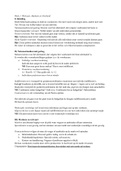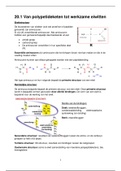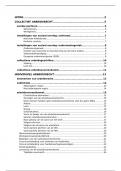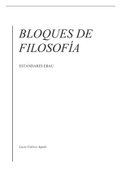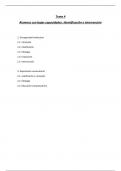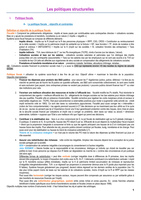For the purposes of the BLS course, age definitions are as follows: - ✔✔✔Adult: after onset of puberty
and older
Children: 1 year to puberty
Infant: <1 year of age
How deep should you compress for each age group? - ✔✔✔Adults: at least 2 inches
Children: at least 1/3 of the depth of the chest; about 2 inches
Infants: at least 1/3 of the depth of the chest; about 1.5 inches
How do you check a pulse in infants and children? - ✔✔✔Infants: palpate a brachial pulse
Children: palpate a carotid or femoral pulse
It can be difficult to BLS providers to determine the presence or absence of a pulse in any victim,
particularly in an infant or child. So if you do not definitely feel a pulse within 10 seconds, start CPR,
beginning with chest compressions
How do you locate the carotid pulse? - ✔✔✔1. Locate the trachea on the side closest to you, using 2-3
fingers
2. Slide fingers into the groove between the trachea and the muscles at the side of the neck, where you
can feel the pulse
3. Feel for a pulse for at least 5 but no more than 10 seconds. If you do not definitely feel a pulse, begin
CPR starting with chest compressions
How do you perform chest compressions in infants? - ✔✔✔Using the 2 finger technique:
1. Place infant on a firm, flat surface
2. Place 2 fingers in the center of the infant's chest, just below the nipple line, on the lower half of the
breastbone. Do not press the tip of the breastbone
, 3. Give compressions at rate of 100-120/min
4. Compress at least 1/3 of chest (about 1.5 inches)
5. Allow full recoil between compressions and minimize interruptions to 10 seconds or less
6. After every 30 compressions open the airway and give 2 breaths, each over 1 second. The chest
should rise after each breath
7. After about 5 cycles of CPR, if you are along and the emergency response system has not been
activated, stop to activate the response system and retrieve the AED
8. Restart CPR with 30:2 ratio and use AED until advanced providers take over or the infant begins to
breathe, move, or otherwise react
How do you place AED pads on someone with a transdermal medication patch? - ✔✔✔Do not place
AED pads directly on top of the medication patch because it may block the transfer of energy from the
AED pad to the heart and also cause small burns. If it does not delay delivery, remove the patch and
wipe the area before attaching pads normally. Use gloves when removing the patch to avoid delivery of
medication to the rescuer
How do you place AED pads on someone with an implanted defibrillator or pacemaker? - ✔✔✔These
devices are easy to identify because they create a hard lump beneath the skin of the upper chest or
abdomen. Avoid placing the AED pad directly over the device but otherwise continue normally
How does rapid defibrillation work and what effect does it have on a patient undergoing cardiac arrest?
- ✔✔✔Rapid defibrillation can identify lethal heart rhythms and deliver a shock to terminate the
abnormal rhythm and allow the heart's normal rhythm to resume. In conjunction with high-quality CPR,
rapid defibrillation can double or triple the chances of survival
How often should rescue breaths be given in infants and children when a pulse is present? - ✔✔✔1
breath every 3-5 seconds
How would you recognize that someone has had cardiac arrest? - ✔✔✔The victim will be
unresponsive, not breathing or only gasping, and no pulse



